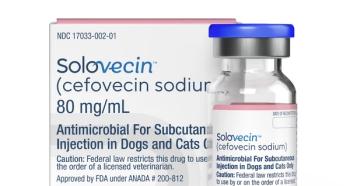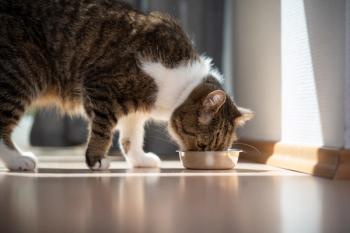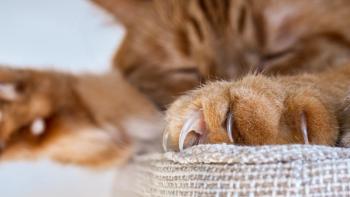
Insulin choices for cats: What works best (Proceedings)
Insulin treatment options for diabetic cats.
Insulin treatment options for Diabetic Cats
A. Stable versus unstable
1. ketotic versus nonketotic
2. attitude
3. appetitie
4. activity level
B. Unstable patient – ketotic/ketoacidotic/hyperosmolar diabetic
1. Goals of therapy
a. correct dehydration/restore normal fluid balance
b. provide insulin
c. correct electrolyte imbalances
d. correct acidosis
e. identify precipitating cause
2. Fluid therapy
a. total body sodium loss
b. 0.9% NaCl w/ K+ (as needed)
c. usually fine even if hyperosmolar
d. correct dehydration and account for ongoing losses
3. Insulin therapy – use Regular crystalling insulin
a. Insulin CRI
(1) blood glucose q 2hr
(2) continuous blood glucose monitoring
b. Intermittent IM/SQ technique
(1) 0.2 U/Kg IM
(2) 0.1U/kg IM q 1 hr until blood glucose <250 mg/dl
(3) regular insulin SQ 0.5-1 U/kg q 6-8 hr once patient is hydrated
4. Correction of electrolyte balances
a. Potassium supplementation
(1) initial
(2) once insulin starts
(3) can add to fluids
b. Phosphorous supplementation
(1) once level gets < 1.5 (dog), <2.5 (cat)
(2) 0.01-0.03 mmol/kg/hr for 6 hours and recheck
c. Magnesium supplementation will help get other electrolyte levels up important in parathyroid hormone synthesis and in correcting hypocalcemia (3) 0.75 – 1.0 mEq/kd/day IV in 5% dextrose over 24-48 hrs
5. Correction of acidosis
a. IV fluids
b. bicarbonate if acidosis severe (<7.0) or doesn't correct with rehydration
c. 0.1 x base deficit x BW (kg) – give 1/3 and recheck
6. Wean to long acting insulin when animal is hydrated and eating. Still may have small amounts of ketones in urine.
C. Stable diabetic, eating/drinking/good attitude
1. Goals of therapy
a. control clinical signs of pet
b. prevent hypoglycemia
c. keep blood glucose between 100-300 mg/dl for most of the animal's day; ideally want blood glucose between 100-200 mg/dl
d. animal to regain normal muscle mass and body weight
2. Food
a. cats: low carbohydrate diet
A. Don't wait too long before starting insulin to prevent amyloid deposition
B. Good 2-3 week trial then if still hyperglycemic, start insulin
b. feeding small amount before insulin (to make sure pet will eat), then give the rest of the meal after insulin given.
c. feed twice per day with insulin
d. free choice feeding
e. small snack can be given 4-6 hours after insulin administration
f. if animal does not eat, give 1/2 insulin and call vet
3. insulin choices
a. source
(1) pork
(2) beef
(3) human recombinant
(4) human mutated
b. type
(1) precipitation agents
(2) protamine
(3) zinc
(4) pH
c. concentration
(1) 40 U/ml (U-40)
(2) 100 U/ml (U-100)
a. most cats need long term insulin twice per day
b. starting dose cats: 0.25 U/kg bid
c. insulin handling
1. keep cool and in a dark place
2. glargine insulin will last up to 6 months if refrigerated
3. roll to mix, don't shake
4. may be diluted; EXCEPT glargine and determir insulins; use diluent provided by manufacturers
d. make sure insulin syringe (measured in units) matches the concentration of insulin in bottle
Newsletter
From exam room tips to practice management insights, get trusted veterinary news delivered straight to your inbox—subscribe to dvm360.






